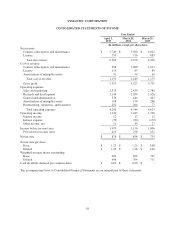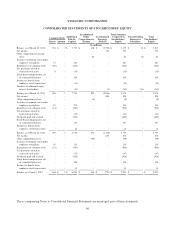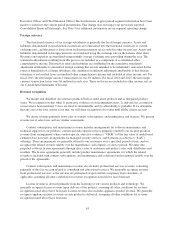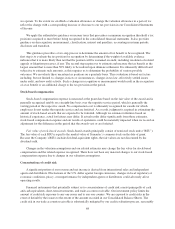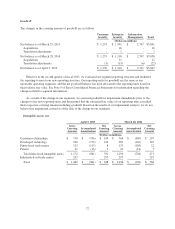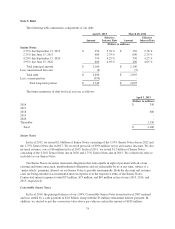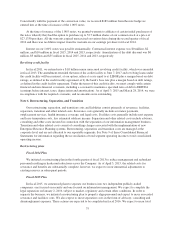Symantec 2015 Annual Report Download - page 143
Download and view the complete annual report
Please find page 143 of the 2015 Symantec annual report below. You can navigate through the pages in the report by either clicking on the pages listed below, or by using the keyword search tool below to find specific information within the annual report.Financial instruments
For assets and liabilities measured at fair value, such amounts are based on an expected exit price
representing the amount that would be received on the sale of an asset or paid to transfer a liability, as the case
may be, in an orderly transaction between market participants. As such, fair value may be based on assumptions
that market participants would use in pricing an asset or liability. The authoritative guidance on fair value
measurements establishes a consistent framework for measuring fair value on either a recurring or nonrecurring
basis whereby inputs used in valuation techniques are assigned a hierarchical level.
The following methods were used to estimate the fair value of each class of financial instruments for which
it is practicable to estimate that value:
Cash equivalents. We consider all highly liquid investments with an original maturity of three months or
less at the time of purchase to be cash equivalents. Cash equivalents are carried at amounts that approximate fair
value due to the short period of time to maturity.
Short-term investments. Short-term investments consist of investment and marketable equity securities that
are classified as available-for-sale and recognized at fair value using Level 1 and Level 2 inputs, which are
quoted using market prices, independent pricing vendors, or other sources, to determine the fair value.
Unrealized gains and losses, net of tax, are included in accumulated other comprehensive income. We regularly
review our investment portfolio to identify and evaluate investments that have indications of impairment. Factors
considered in determining whether a loss is other-than-temporary include: the length of time and extent to which
the fair value has been lower than the cost basis, the financial condition and near-term prospects of the investee,
credit quality, likelihood of recovery, and our ability to hold the investment for a period of time sufficient to
allow for any anticipated recovery in market value.
Debt. Our debt has included senior unsecured notes, convertible senior notes, and a revolving credit
facility. Our senior unsecured notes are recorded at cost based upon par value at issuance less discounts. The
discount associated with our senior unsecured notes represents the amount by which the face value exceeds the
issuance price. The discount and issuance costs (recognized initially in the other long-term assets) are amortized
using the effective interest rate method over the term of the debt as a non-cash charge to interest expense.
Borrowings under our $1.0 billion senior unsecured revolving credit facility (“credit facility”) would be
recognized at cost plus accrued interest based upon stated interest rates.
Trade accounts receivable
Trade accounts receivable are recorded at the invoiced amount and are not interest bearing. We maintain an
allowance for doubtful accounts to reserve for potentially uncollectible trade receivables. Additions to the
allowance for doubtful accounts are recorded as general and administrative expenses. We review our trade
receivables by aging category to identify specific customers with known disputes or collectability issues. In
addition, we maintain an allowance for all other receivables not included in the specific reserve by applying
specific percentages of projected uncollectible receivables to the various aging categories. In determining these
percentages, we analyze our historical collection experience and current economic trends. We exercise judgment
when determining the adequacy of these reserves as we evaluate historical bad debt trends, general economic
conditions in the U.S. and internationally, and changes in customer financial conditions. We also offset deferred
revenue against accounts receivable when channel inventories are in excess of specified levels and for
transactions where collection of a receivable is not considered probable.
65





